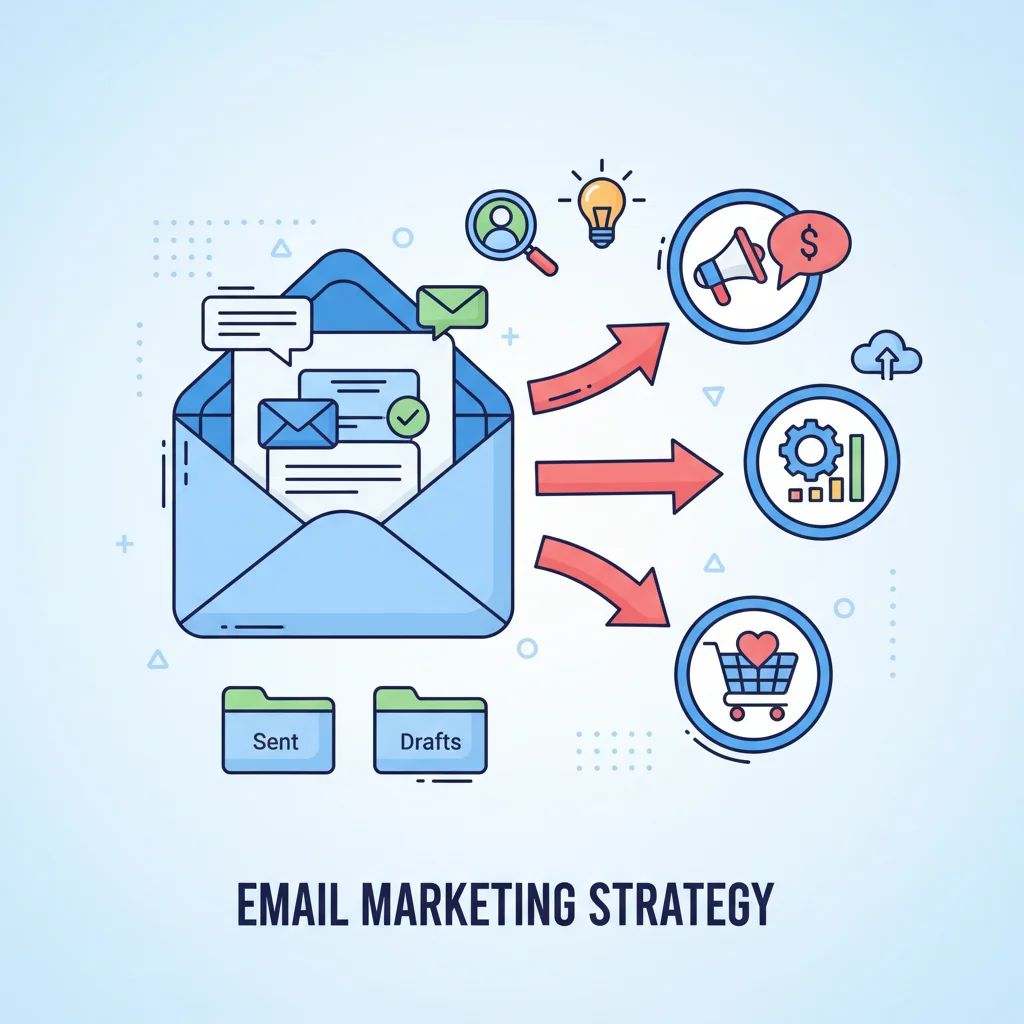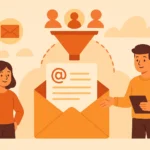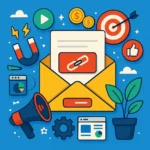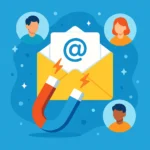Now Reading: Email Marketing vs Newsletter Differences: Choose Your Strategy
-
01
Email Marketing vs Newsletter Differences: Choose Your Strategy
Email Marketing vs Newsletter Differences: Choose Your Strategy

Are you sending newsletters when you should be sending marketing emails? Or maybe you’re hitting your subscribers with sales pitches when they’re expecting valuable content? The email marketing vs newsletter differences might seem subtle, but getting them wrong can cost you subscribers, sales, and sanity. I’m about to reveal the exact framework that separates these two approaches – and how knowing the difference can double your engagement rates overnight.
Key Takeaways
What is the difference between email marketing and email newsletters?
- Email marketing is a broader strategy that includes all promotional emails sent to drive specific actions (purchases, sign-ups, downloads), while newsletters are a specific type of email focused on delivering valuable, informational content on a regular schedule.
- Purpose: Marketing emails aim to convert leads into customers; newsletters build relationships and establish authority.
- Content: Marketing emails are promotional and action-oriented; newsletters are educational and informative.
- Design: Marketing emails feature prominent CTAs and focused messaging; newsletters contain multiple content sections and stories.
- Frequency: Marketing emails are triggered by specific events or campaigns; newsletters follow a consistent publishing schedule.
What Exactly Is Email Marketing?
Email marketing is the big umbrella term covering all types of business emails you send to your audience. It’s the entire strategy of using email as a channel to communicate with prospects and customers.
Think of email marketing as your complete toolkit. It includes:
- Welcome sequences
- Abandoned cart reminders
- Product launches
- Special promotions
- Re-engagement campaigns
- Transactional emails
- And yes, newsletters too!
The primary goal of email marketing is to drive specific actions that contribute to your business objectives – whether that’s making a sale, booking a consultation, or downloading a resource.
Useful Articles:
What Is an Email Newsletter?
A newsletter is just one specific tool within your email marketing arsenal. It’s a regular publication sent to subscribers that delivers valuable, informative content rather than directly pushing for sales.
Newsletters are like the digital equivalent of a magazine subscription that arrives on schedule. They’re designed to:
- Keep your brand top-of-mind
- Share industry insights and company updates
- Provide educational content
- Build relationships with your audience
- Establish your authority in your field
The key distinction? While marketing emails are primarily promotional, newsletters focus on delivering value first, with promotional elements taking a backseat.
Core Differences Between Email Marketing and Newsletters
Purpose and Intent
The most fundamental email marketing vs newsletter difference lies in their purpose:
Marketing Email Purpose:
- Drive immediate action
- Generate sales or leads
- Promote specific products or services
- Create urgency around limited-time offers
Newsletter Purpose:
- Build long-term relationships
- Provide valuable information
- Establish brand authority
- Keep subscribers engaged between purchases
I like to think of marketing emails as asking for something (a purchase, sign-up, etc.), while newsletters are giving something (information, entertainment, insights).
Content Structure and Focus
The content structure reflects these different purposes:
Marketing Email Content:
- Single-focused message
- Clear, prominent call-to-action
- Product or service-centric information
- Benefits-driven copy
- Conversion-optimized design
Newsletter Content:
- Multiple topics or sections
- Educational or informative articles
- Industry news and updates
- Company announcements
- Curated resources
- Subtle promotional mentions
For example, a marketing email might focus entirely on promoting a new product launch with features, benefits, and a “Buy Now” button. A newsletter might include a brief mention of that new product alongside industry news, helpful tips, and customer spotlights.
Design Elements
The visual presentation of these emails also differs significantly:
Marketing Email Design:
- Clean, focused layout
- Limited distractions
- Prominent CTA buttons
- Product imagery
- Conversion-focused elements
Newsletter Design:
- Editorial layout with distinct sections
- Table of contents for longer editions
- Multiple links throughout
- Mix of imagery types
- Content-focused elements
Marketing emails are designed to guide the eye toward a single action, while newsletters are structured more like a digital magazine that encourages exploration.
Frequency and Timing
When and how often you send these emails also differs:
Marketing Email Timing:
- Triggered by specific events or campaigns
- Sent based on customer behavior
- Often part of a sequence or automation
- Timing optimized for conversion
Newsletter Timing:
- Regular, predictable schedule (weekly, monthly)
- Consistent delivery day and time
- Standalone or part of a content calendar
- Timing optimized for engagement
Your subscribers come to expect newsletters at regular intervals, while marketing emails arrive based on specific triggers or campaigns.
Tone and Voice
Even the way you communicate changes between these email types:
Marketing Email Tone:
- Persuasive and action-oriented
- Creates urgency or excitement
- Focuses on benefits and solutions
- Direct and concise
Newsletter Tone:
- Conversational and informative
- Educational and helpful
- Builds trust through expertise
- More relaxed and editorial
Marketing emails sound more like a sales conversation, while newsletters feel more like helpful advice from a trusted friend.
Useful Articles:
When to Use Email Marketing vs Newsletters
Knowing when to deploy each type of email is crucial for maximizing your results.
When to Send Marketing Emails
Marketing emails shine in these scenarios:
- New product or service launches – When you’re introducing something new to the market
- Limited-time promotions – Sales, discounts, or special offers with a deadline
- Cart abandonment recovery – Reminding customers about products they’ve shown interest in
- Event registrations – Driving sign-ups for webinars, workshops, or in-person events
- Re-engagement campaigns – Winning back inactive subscribers
- Upsell or cross-sell opportunities – Suggesting complementary products to existing customers
I recently helped a client increase their sales by 32% by switching from a generic newsletter to a targeted marketing email for their product launch. The focused message and clear CTA made all the difference.
When to Send Newsletters
Newsletters are ideal for:
- Regular updates – Keeping your audience informed about industry trends
- Relationship building – Nurturing prospects who aren’t ready to buy
- Thought leadership – Establishing your brand as an authority
- Community building – Fostering connection among your audience
- Content distribution – Sharing your blog posts, videos, or podcasts
- Brand awareness – Staying top-of-mind between purchases
One of my clients uses a monthly newsletter to share industry insights, and it’s become their top source of consultation bookings – not because it directly promotes their services, but because it demonstrates their expertise.
Content Strategy for Email Marketing vs Newsletters
Creating Effective Marketing Emails
To create marketing emails that convert:
- Focus on a single objective – Each email should have one primary goal
- Craft compelling subject lines – Create urgency or curiosity to boost open rates
- Keep it concise – Respect your reader’s time with brief, scannable content
- Make benefits clear – Explain what’s in it for them, not just features
- Use strong CTAs – Make your call-to-action obvious and compelling
- Personalize when possible – Use subscriber data to tailor your message
- Create a sense of urgency – Give people a reason to act now
For example, instead of “Check out our new product,” try “The solution to [specific problem] is here – but only until Friday!”
Developing Engaging Newsletters
For newsletters that keep subscribers looking forward to your next issue:
- Create a consistent format – Develop recognizable sections readers can navigate easily
- Provide genuine value – Share insights, tips, or information they can’t easily find elsewhere
- Curate relevant content – Include a mix of your content and industry resources
- Tell stories – Use narrative elements to make your newsletter more engaging
- Follow the 90/10 rule – 90% valuable content, 10% promotion
- Develop a distinct voice – Let your brand personality shine through
- Encourage two-way communication – Invite replies and feedback
My most successful newsletter clients treat their emails like a premium publication, not an afterthought.
Useful Articles:
How to Integrate Both Strategies Effectively
The most successful email programs don’t choose between marketing emails and newsletters – they strategically use both.
The Ideal Email Mix
Based on my experience working with dozens of clients, here’s what works:
- Core newsletter – A regular publication (weekly or monthly) that builds relationships and delivers value
- Targeted marketing campaigns – Strategic promotional emails sent based on subscriber behavior and business goals
- Hybrid approach for launches – Using newsletters to tease upcoming products, followed by focused marketing emails
This balanced approach keeps subscribers engaged while still driving revenue.
Segmentation Is Key
The secret to making both types of emails work together is proper segmentation:
- Engagement-based segments – Send more newsletters to cold leads and more marketing emails to engaged subscribers
- Interest-based segments – Tailor both newsletters and marketing emails to specific topics subscribers care about
- Customer journey segments – Adjust your approach based on where people are in their relationship with your brand
For example, new subscribers might receive a welcome sequence of marketing emails, then transition to primarily newsletters until they show interest in specific products.
Comparison Table
| Feature | Marketing Emails | Newsletters |
|---|---|---|
| Primary Purpose | Drive specific actions | Build relationships |
| Content Type | Promotional, focused on offers | Educational, informative |
| Frequency | Triggered by events or campaigns | Regular schedule (weekly, monthly) |
| Design | Action-oriented with prominent CTAs | Content-focused with multiple sections |
| Ideal Ratio | 90% value to reader, 10% promotion | 90% valuable content, 10% promotion |
| Success Metrics | Conversions, revenue, ROI | Engagement, opens, content interaction |
| Tone | Persuasive, urgent | Conversational, informative |
| Length | Brief, focused | More comprehensive |
| Personalization | Highly targeted | Broader appeal |
Marketing Email Example
Subject line: “Last chance: 30% off ends tonight”
Body: Brief explanation of the sale, highlighting top products, clear benefits of acting now, and a prominent “Shop Now” button.
This email has one clear purpose – drive immediate sales before the promotion ends.
Newsletter Example
Subject line: “5 industry trends you need to know this month”
Body: Introduction from the editor, 5 trend summaries with links to learn more, a customer spotlight section, upcoming events calendar, and a small promotional section at the bottom highlighting a relevant product.
This email delivers value first, with promotion taking a backseat to useful information.
Getting Started With Both Strategies
Ready to implement both approaches? Here’s how to get started:
Step 1: Define Your Goals
Be clear about what you want to achieve with each type of email:
- What specific actions do you want marketing emails to drive?
- What value do you want newsletters to provide?
Step 2: Set Up Your Calendar
Create a publishing schedule that balances both types:
- Determine your newsletter frequency (weekly, bi-weekly, monthly)
- Plan marketing campaigns around key business objectives
- Avoid overwhelming subscribers with too many emails
Step 3: Develop Your Templates
Create distinct designs for each purpose:
- Marketing email templates should be conversion-focused
- Newsletter templates should be content-focused
- Both should reflect your brand identity
Step 4: Build Your Segments
Develop audience segments based on:
- Engagement level
- Purchase history
- Content preferences
- Position in customer journey
Step 5: Create Content Workflows
Establish processes for creating both types of emails:
- Newsletter editorial calendar
- Marketing campaign briefs
- Approval workflows
- Testing procedures
I’ve found that having separate workflows for newsletters vs marketing emails helps maintain the distinct purpose of each.
Understanding the email marketing vs newsletter differences isn’t just about knowing definitions – it’s about strategically using both tools to build relationships AND drive revenue. By recognizing when to inform and when to sell, you’ll create an email strategy that subscribers actually look forward to engaging with. And that’s the real secret to email marketing success: creating communications your audience genuinely wants to receive.





















